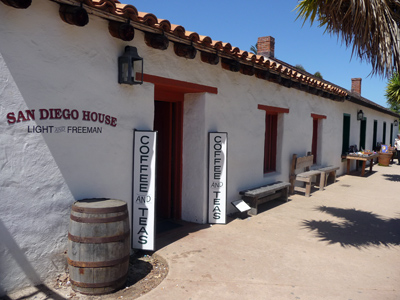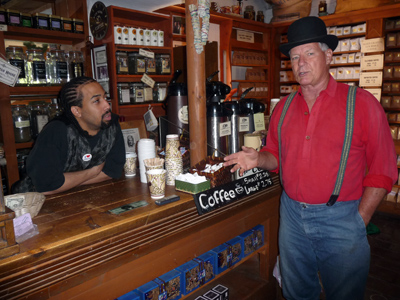
By Donald H. Harrison

SAN DIEGO—The exterior of the San Diego House adobe in Old Town San Diego State Historic Park is unremarkable, but historians will tell you that the building had a way of attracting to its ownership over the last century and a half the kind of people of whom legends were made.
Henry Fitch, Allen Light and good, good, Leroy Brown are among the San Diegans who have been proprietors here . We call the latter ‘good, good’ because so many people in San Diego know Jim Croce’s song about that ‘Bad, Bad Leroy Brown,” obviously inspired by someone else. Croce’s wife, Ingrid, operates a restaurant and bar in San Diego’s Gaslamp Quarter, so among San Diegans, it may be important to clarify that the Leroy Brown who owns the packaged coffee and tea shop inside San Diego House spent most of his life as a grocer, not as a diamond-wearing, El Dorado-driving gambler.
In the 1970s, Brown purchased the 54th Street branch of the Big Bear Market chain and renamed it Brown’s Town & County Market, thereby gaining a reputation as one of the city’s successful black entrepreneurs. Around 1995, he leased the San Diego House, which he turned into a shop where one could buy coffees and teas from all over the world and also learn about the lives of two predecessor African-American entrepreneurs in San Diego, Allen Light and Richard Freeman.

Behind the counter of the family-owned store today, you might meet Leroy’s son, Andre, or his grandson Andre Leroy Brown, who was on duty and visiting with costumed Old Town docent Dick Miller—a former state park ranger—the day I happened in.
Teas and coffees draw tourists from all parts of the world, many of them curious to see whether the Lights have on stock those beans or leaves that come from their own countries. South Africans look for red teas, Japanese green teas, and the British what they call “a proper cup of tea,” laughs Andre Leroy Brown. “It has to be steeped three minutes, and only afterwards do you put in the milk.”
Some of the customers are just as fussy about coffees—with Brazilians saying beans picked in their country are superior to those from anywhere else, and Americans not caring so much where the beans come from, so long as they can be made into lattes, notes Brown.
Allen B. Light came to California in the mid 1830s aboard the trading brig Pilgrim, known to historians because it also carried Richard Henry Dana, author of Two Years Before the Mast. Born a slave, Light had purchased his freedom and worked his way to California as a steward – thus his nickname ‘Black Steward.’ After he jumped ship in California and started hunting coastal game, the world learned that Light also was an incredibly good marksman. Historians say he could bounce on the waves in a kayak or canoe and shoot a ball into the skull an otter, without damaging its valuable pelt.
This activity brought him into conflict with Mexican authorities, who forbade foreigners to hunt in California without a license from the governor, according to research by the historical society in Santa Barbara, where Light’s marksmanship was legend.
Light got around this problem by accepting employment from Captain George Nidever, who had the requisite license. Eventually, the Mexican government decided that it needed such a talent as Light’s patrolling the California coastline. The government appointed Light as a game warden in charge of protecting the otter.
There were many people to protect the mammals from. American traders hired indigenous hunters, not only from California but from places as far removed as the Hawaiian and Aleutian Islands, to seek the otter. The hunters knew that the skins of the animals fetched unimaginably high prices in China.
Light’s reputation as a marksman usually stood him in good stead, except with one opponent he encountered in a cave in Central California. It was an angry California Grizzly Bear, who slashed Light with his claws, ripping pieces from the hunter. Somehow, Light was able to kill the bear with his knife, adding to his reputation as a formidable fighting man.
In addition to holding public office as a game warden, Light decided to become an entrepreneur and, along with Richard Freeman, purchased the saloon operated inside the San Diego House. The seller, Henry Fitch, was another of its famous entrepreneurs.
Around 1850, Light headed north again to Gold Rush Country, and what he did, and what happened to him, are mysteries. Little is known about his business partner Freeman, except that he worked for the San Diego Sheriff and died in 1851, a year after California because the 31st state of the United States.
The man from whom Light and Freeman had purchased the saloon – Henry Fitch—was known more for his spirit than for the spirits vended by his saloon. The former sea captain had fallen in love with Josefa Carrillo, daughter of one of the prominent families in San Diego, and in accordance with Mexican law, converted from his Protestant faith to Catholicism to become eligible to marry her. Although Josefa’s family had approved the marriage, Gov. Jose Maria Echeandia had not, so on the very day of the ceremony issued a decree prohibiting it.
According to the oft-told story, the broken hearted Josefa whispered the suggestion to Henry (Enrique), “Why don’t you carry me away?” and by the next night he had arranged to do just that. With the help of Pio Pico, who later in his life would become California’s last Mexican governor, Josefa was brought on horseback to San Diego Bay, where Fitch awaited her aboard a ship. They sailed away to Chile, where they were married by a priest in Valparaiso.
Notwithstanding the fact that the ceremony had been performed by a church official, the couple’s elopement was considered an offense against the provincial Mexican government in California. Knowing that, the couple didn’t return until Josefa had a child in arms. As they suspected, the Carrillos melted, but Fitch was briefly imprisoned and forced to pay a hefty fine. It was after their return that Fitch became a San Diego merchant.
*
Harrison is editor of San Diego Jewish World